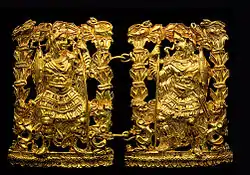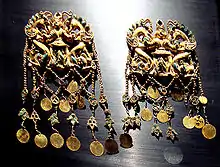National Museum of Afghanistan
The National Museum of Afghanistan (Persian: موزیم ملی افغانستان, Mūzīyam-e mellī-ye Afghānestān; Pashto: د افغانستان ملی موزیم, Də Afghānistān Millī Mūzīyəm), also known as the Kabul Museum, is a two-story building located 9 km southwest of the center of Kabul in Afghanistan. As of 2014, the museum is under major expansion according to international standards, with a larger size adjoining garden for visitors to relax and walk around.[1][2] The museum was once considered to be one of the world's finest.[3][4]
 Outside the Afghan National Museum in 2010 | |

| |
| Established | 1922 |
|---|---|
| Location | Darulaman, District 6, Kabul, Afghanistan |
| Collection size | approx. 100,000 as of 1978; now about 30,000 |
The museum's collection had earlier been one of the most important in Central Asia,[5] with over 100,000 items dating back several millennia, including items from Persian, Buddhist and Islamic dynasties. With the start of the civil war in 1992, the museum was looted numerous times and destroyed by rockets, resulting in a loss of 70% of the 100,000 objects on display.[6][7] Since 2007, a number of international organizations have helped to recover over 8,000 artifacts, the most recent being a limestone sculpture from Germany.[8] Approximately 843 artifacts were returned by the United Kingdom in 2012, including the famous 1st Century Begram ivories.[9]
History
The Afghan National Museum was opened in 1919 during the reign of King Amanullah Khan.[10] The collection was originally inside the Bagh-e Bala Palace, but was moved in 1922 and began as a 'Cabinet of Curiosities'.[11] It was moved to its present location in 1931.[12] Historian Nancy Dupree co-authored A Guide to the Kabul Museum in 1964. In 1973, a Danish architect was hired to design a new building for the museum, but the plans were never carried out.[13] In 1989, the Bactrian Gold had been moved to an underground vault at the Central Bank of Afghanistan.[6]

After the collapse of President Najibullah's government and the start of a brutal civil war in the early 1990s, the museum was looted numerous times resulting in a loss of 70% of the 100,000 objects on display.[6] A rocket attack in May 1993 buried ancient potteries under debris.[14] In March 1994, the museum, which had been used as a military base, was struck by rocket fire and largely destroyed. The Ministry of Information and Culture of President Rabbani's government ordered that the 71 museum staff begin moving the inventory to Kabul Hotel (now Serena Hotel) in order to rescue them from further rocketing and shelling.[13] In September 1996, staff at the museum completed the cataloging of the remaining materials.[5] In February and March 2001, the Taliban destroyed countless pieces of art.[15] It was reported in November 2001 that the Taliban had destroyed at least 2,750 ancient works of art during the year.[16]
.jpg.webp)
Between 2003 and 2006, about $350,000 was spent to refurbish the building. Many of the most precious objects had been sealed in metal boxes and removed for safety and were recovered and inventoried in 2004.[17] Some archeological objects were found in vaults in Kabul,[18] while a collection was also discovered in Switzerland.[19] Since 2007, UNESCO and Interpol have helped to recover over 8,000 artefacts, the most recent being a limestone sculpture from Germany[8] and 843 artefacts returned by the British Museum in July 2012, including the famous 1st Century Begram Ivories.[9]
In 2012, an architecture firm from Spain won a competition for the new design of the Afghan National Museum.[1] Work began in 2013 to expand the museum according to international standards, with a large adjoining garden for visitors to relax and walk around.[2]
Collections
.jpg.webp)
Many treasures of ivory are stored there, as are antiquities from Kushan, early Buddhism, and early Islam. One of the most famous pieces in the museum, and known to have survived the turbulent period in the 1990s is the Rabatak Inscription of King Kanishka.
Archaeological Materials
As the National Museum Kabul has been the repository for many of the most spectacular archaeological finds in the country. These include the painted frescos from Dilberjin; inscriptions, fragments of architecture, sculpture, metal objects, and coins rescued from the French excavations at Ai-Khanoum and Surkh Kotal; the spectacular collection of objects found at a merchants warehouse in the city of Bagram, which include ivories from India, mirrors from China, and glassware from the Roman Empire; the stucco heads of Hadda; Buddhist sculpture from Tepe Sardar and other monastic institutions in Afghanistan; and a large collection of Islamic art from the Ghazvanid and Timurid periods found at Ghazni.[20]
Numismatic Collection
The National Museum has a large collection of coins, the Austrian numismatist Robert Göbl[21] reported it contained 30,000 objects during a UNESCO sponsored audit of the collection. It is unknown how much the collection has grown since or what was lost during the various wars since. The collection contains the bulk of archaeological material recovered in Afghanistan. It has not been published, but individual hoards and archaeological sites have been. The French Archaeological Delegation in Afghanistan (DAFA) published the coin finds made at the town of Surkh Kotal. Some of the coins found at the excavation of Begram have been published.[22] Part of the Mir Zakah hoard, a very unusual deposit containing enormous numbers of coins from the fourth century BC to third century AD, totalling 11,500 silver and copper coins were kept in the museum. Part of the hoard was published by DAFA.[23] The museum has appointed a curator for Numismatics but the collection remains closed to scholars and the general public.[24]
The travelling collection
Certain important parts of the collection, including material from Begram, Ai Khanum, Tepe Fullol, and the gold jewellery from all six of the excavated burials at Tillya Tepe, have been on travelling exhibition since 2006. They have been exhibited at the Guimet Museum in France, Four museums in the US, the Canadian Museum of Civilization, the Bonn Museum in Germany, and most recently to the British Museum. They continue to tour and will eventually return to the National Museum.[25]
Gallery
References
- Bustler. "Winners of the National Museum of Afghanistan Competition".
- "U.S. and Afghan Officials Inaugurate New Facilities for the National Museum". kabul.usembassy.gov. December 5, 2013. Archived from the original on February 1, 2014. Retrieved 2014-01-24.
- From Our Own Correspondent - a celebration of fifty years of the BBC Radio Programme by Tony Grant
- Games without Rules: The Often-Interrupted History of Afghanistan by Tamim Ansary
- Girardet, Edward; Jonathan Walter, eds. (1998). Afghanistan. Geneva: CROSSLINES Communications, Ltd. p. 291.
- Lawson, Alastair (1 March 2011). "Afghan gold: How the country's heritage was saved". BBC. Retrieved 1 March 2011.
- https://www.nytimes.com/1996/11/30/world/kabul-s-museum-the-past-ruined-by-the-present.html
- (31 January 2012) Germany returns Afghan sculpture bbc.co.uk/news/
- (19 July 2012) Looted art returned to Afghanistan, bbc.co.uk
- Afghanistan: Hidden Treasures from the National Museum, Kabul (2008), p. 35. Eds., Friedrik Hiebert and Pierre Cambon. National Geographic, Washington, D.C. ISBN 978-1-4262-0374-9.
- Meharry, Joanie Eva "The National Museum of Afghanistan: In Times of War", The Levantine Review
- "National Museum of Afghanistan - SILK ROAD". en.unesco.org.
- Grissmann, Carla (February 19, 2004). "KABUL MUSEUM". In Ehsan Yarshater (ed.). Encyclopædia Iranica (Online ed.). United States: Columbia University.
- "Museum Under Siege: Full Text - Archaeology Magazine Archive". archive.archaeology.org.
- "Destruction in Kabul: I watched as the Taliban destroyed my life's work". BBC News. 20 January 2016. Retrieved 15 February 2019.
- "Taliban destroyed museum exhibits". 23 November 2001 – via www.telegraph.co.uk.
- Afghanistan: Hidden Treasures from the National Museum, Kabul (2008), pp. 37-53. Eds., Friedrik Hiebert and Pierre Cambon. National Geographic, Washington, D.C. ISBN 978-1-4262-0374-9.
- "Interviews: Priceless Afghan Treasures Recovered".
- "Afghan treasures return to Kabul". BBC News. 17 March 2007.
- Tissot, F (2006) Catalogue of the National Museum of Afghanistan 1931-1985, UNESCO Publishing
- Göbl, Robert (4 July 1962). "Report on mission as field expert numismatist at the National Museum at Kabul: Afghanistan" (PDF). UNESCO. Retrieved 15 February 2019.
- Ghrishman, 1946
- Curiel, R and Schlumberger, D (1953) Tresors Monetaires D'Afghanistan MDAFA XIV: 65-97
- Journal of the Oriental Numismatic Society, No. 207
- Cambon, P Afghanistan les tresors retrouves, Paris 2007
External links
| Wikimedia Commons has media related to National Museum of Afghanistan. |
- Hidden Treasures from the National Museum, Kabul | National Geographic
- Website National Museum of Afghanistan
- Gold Exhibit
- The Pillage of Kabul Museum
- Museum Under Siege by Nancy Hatch Dupree
- "Lost" Afghan Treasures Found at the Wayback Machine (archived February 8, 2005)
- Association for the Protection of Afghan Archeology






